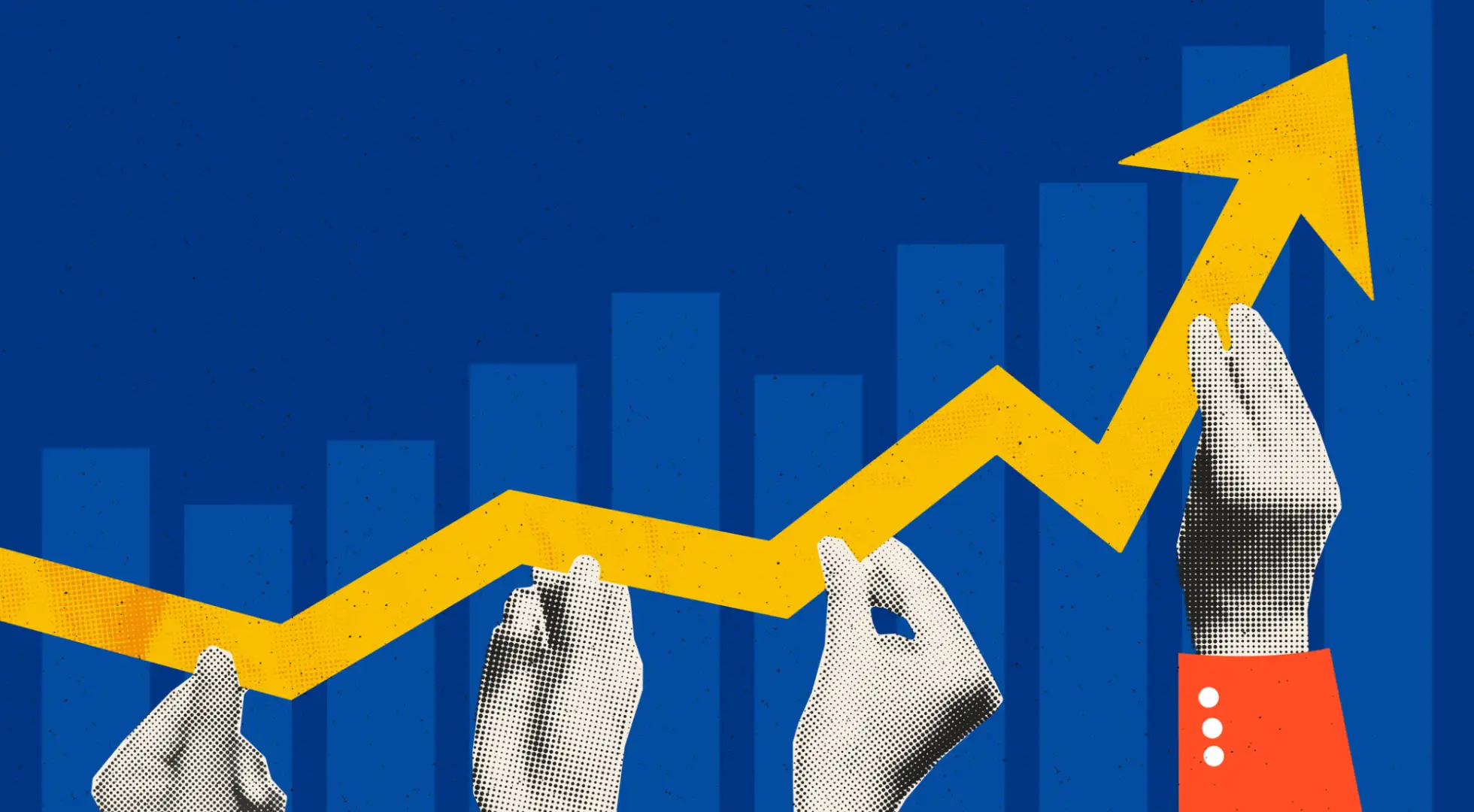
We’ll cut to the chase: yes, homes are much less affordable now than they’ve been in decades, according to our analysis of home price and income data going back to 1971. Today’s median-priced home, costing $412,300, eats up 49% of the median monthly salary in 2024 – just as it did in 1988, when the median price of a home was $110,000.
What’s more, this unaffordability has actually gotten better over the last several months. In the third quarter of 2023, it took 53% of the median income to buy a median-priced house. Before 2022, you’d have to go back to Q2 1990 to find a time that was similarly as unaffordable.
But as rough as it is right now for homebuyers, it could be worse. Nearly the entire decade of the 1980s was the same or worse in terms of affordability, with a house payment requiring about 50% to 60% of the median income – spiking to 72% in Q4 of 1981.
Here’s how we got here, what we can expect in the near future, and what might happen to improve affordability over the coming decade.
It Hurts Because Of Where We Came From
Part of why today’s homes feel so unaffordable is because we’re coming out of some of the most affordable years on record. In Q2 2020, for example, it took just 31% of the median income to buy a median-priced home. You have to go back to Q4 2011 to match that level of affordability — and before that, 1973.
A mortgage-to-income ratio of 31% is at least close to what experts recommend for a front-end debt-to-income ratio, which is 28%. But the last time the median mortgage payment was 28% or less of the median home price was in the second quarter of 1972, when the ratio was 27% and Richard Nixon was president.
Even before the relative affordability of that early pandemic era, the U.S. housing market had just spent an entire decade – 2009 to 2019 – when homes were within the grasp of people who wanted them. The nation had begun to recover from the global financial crisis and average hourly earnings rose by 6.6% over that time, according to the U.S. Bureau of Labor Statistics. That outpaced inflation, which averaged 1.8% each year over the same time frame.
Median home prices ranged between $208,400 and $337,900 during that decade, while the median monthly household income rose from $4,148 to $5,725. And mortgage rates were reasonable, too, brushing 5.6% on a 30-year fixed in 2009 before dropping to around 3.5% in 2012, 2013, 2016, and 2019.
Then the pandemic hit.
Just when homebuyers had gotten used to good times, the nation experienced a double whammy of skyrocketing home prices, thanks to artificially low rates for two years, combined with mortgage interest rates that then rapidly doubled or even tripled.
One of the main drivers of this deteriorated housing affordability is that mortgage rate shock, which went from around 3% to 7% in 2022 alone, combined with the Federal Reserve's rate-hiking cycle designed to slow inflation. Rates slowly began to drop over 2024 before popping again in late September and October, just ahead of the presidential election.
“The recent spike in mortgage rates is a headwind for housing activity,” said Zillow senior economist Kara Ng in a statement. “If the U.S. economy continues to show resilience, there is a floor on how low mortgage rates could fall, and affordability will remain a challenge,” she warns.
Though the Fed began taking steps in September and again in November to drop the fed funds rate by a total of 75 basis points in 2024, housing affordability is near its worst level in around four decades.
The last time it was this bad, Prince was opening for the Rolling Stones.
The Good, the Bad, the 80s
Affordability hit an all-time low in Q4 1981 when the mortgage payment on a median-priced home ($1,145.91) would eat up 72% of the median household income ($1,589.17). As it turns out, the Baby Boomers who remind us about the unaffordable homes they bought in the 1980s aren’t entirely misremembering things.
“I laugh because I remember my dad being like, ‘You got it lucky, Ralph.’ Back when he bought the first home, in the mid-1980s when I was growing up, he had something like a 16% mortgage rate,” said Ralph McLaughlin, a senior economist at Realtor.com.
“I was like, ‘Yeah, well, Dad, you know, that meant that home prices were going to be relatively low compared to your income,” McLaughlin pointed out. By 1985, the median monthly mortgage payment was back to 45% of monthly income – similar to the ratios of late 2022 and 2023. “There's really no such thing as a free lunch when it comes to how mortgage rates, over the long run, affect home prices,” he said.
McLaughlin also pointed out that in the 1980s, the nation was coming off a 30-year period of high supply. “U.S. homebuilders were just maniacs,” during that period, he said. “They were just going absolutely crazy building homes,” starting in the 1950s post-war period and continuing for decades.
That meant the 1980s was a unique sweet spot, where high rates kept prices in check while decades of post-war construction ensured plenty of supply. Plus, as rates fell again into the 1990s, all those homebuyers had the ability to refinance to a lower rate while at the same building equity as prices began to rise again.
Will Affordability Ever Return?
If you’re waiting for affordability to return to the levels we saw in the mid-2010s (after a worldwide financial crisis depressed both rates and prices), you may want to find a seat and get comfortable.
“You have to look at the structural components of the U.S. housing market to look at affordability, and that is fundamentally, these days, the relative amount of supply compared to demand,” McLaughlin said.
Kevin Ryan, president and CFO of mortgage fintech Better.com, explains it this way: “In 2010, the U.S. housing market was still recovering from the devastating impact of the 2008 financial crisis,” he said. “The market was marked by high levels of housing inventory, as foreclosures flooded the market, while demand remained suppressed due to high unemployment and economic uncertainty. Today’s housing market faces the opposite situation from 2010.
“Instead of high inventory and low demand, we now have limited supply and strong demand, pushing prices to record highs,” he continued. “The ‘lock-in’ effect, where homeowners with low-rate mortgages avoid selling, further tightens supply. Even with potential declines in mortgage rates, the structural shortage of homes and high demand make a return to mid-2010 affordability levels unlikely, barring a major economic shift.”
In other words, lower rates – while much appreciated – won’t be the answer to the affordability problem. Increasing the supply could be, though. One of the major levers in that equation is the “silver tsunami” of aging Baby Boomers finally relinquishing properties, enabling the millions of Millennials and Gen Z-ers who have been sitting on the sidelines to grab the first rung of the property ladder.
Another hope is that home builders keep pace with demand, or even outpace demand, and that an increase in productivity (perhaps thanks to AI) allows wages to rise faster than home prices, McLaughlin said.
But those possibilities look to be a decade or more in the future. What can homebuyers do now?
How to Deal With Unaffordability
“Prepare to be disappointed,” McLaughlin cautions first-time homebuyers hoping to enter the market. “I’ve learned with anything – and I think this should apply to first-time homebuyers – having low expectations in life leads to periods of happiness, because not everything in the world disappoints all the time.”
But the economist is not without compassion for would-be buyers. “It’s certainly tough. I’ll say that for first-time homebuyers. But it’s not impossible … there are a few signs,” he noted.
Buyers hoping to find a lucky break would do well to keep a sharp eye out for another 1980s-like sweet spot, where rates come back down but before they are recapitalized back into home prices. “It would be a nice little window of opportunity if you’re kind of on the cusp of qualifying for a mortgage,” he said.
It remains to be seen what other opportunities could include; perhaps possible federal programs that could be on the horizon after the presidential transition, such as building more housing on federal land, or reducing regulations that might make it easier for builders to offer homes at lower price points.
There also may be some other tips from the 1980s for today’s would-be buyers to borrow.
“Many families in the 1980s turned to adjustable-rate mortgages (ARMs) offering lower initial rates, or opted for smaller homes to keep costs down,” said Ryan. Dual-income households added more income to the equation, while government programs, like FHA loans, provided access to homeownership through lower down payments.
Refinancing when rates decline can also provide an opportunity to lower your costs when market conditions change, he said.
Anthony Grosso, a senior loan officer at Green River Capital, points out a silver lining.
“The benefit of having the higher interest rate environment now is this is probably the highest you're going to be, minus taxes and things going up,” he said. “But you're going to refinance at some point, and it's going to come down, so you'll be in a better spot.”
Keep your eyes peeled for opportunities, and remember that what goes up, very often, does indeed eventually come down … even if it takes a few years.






